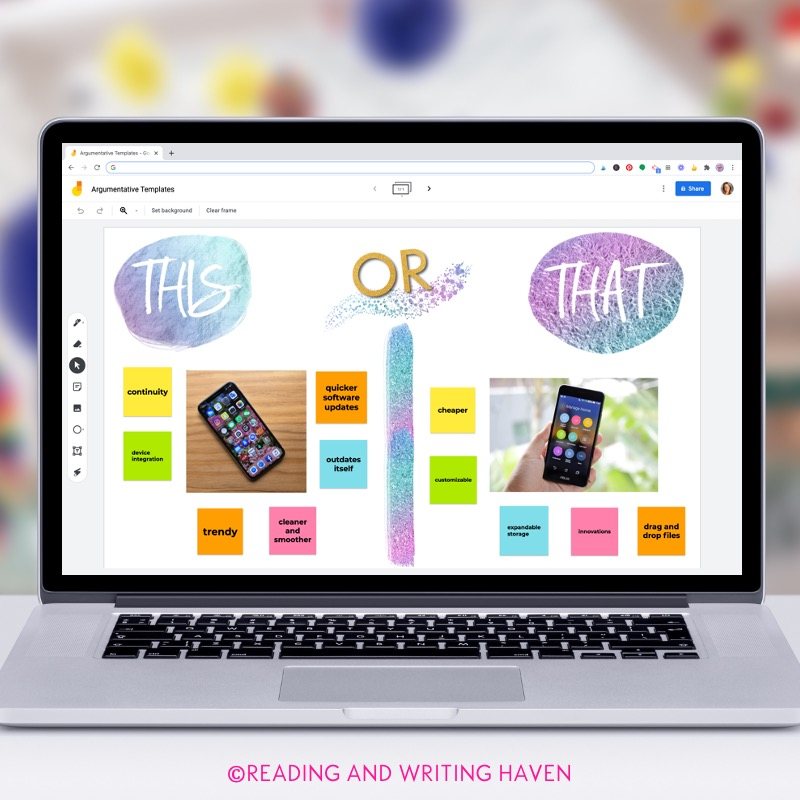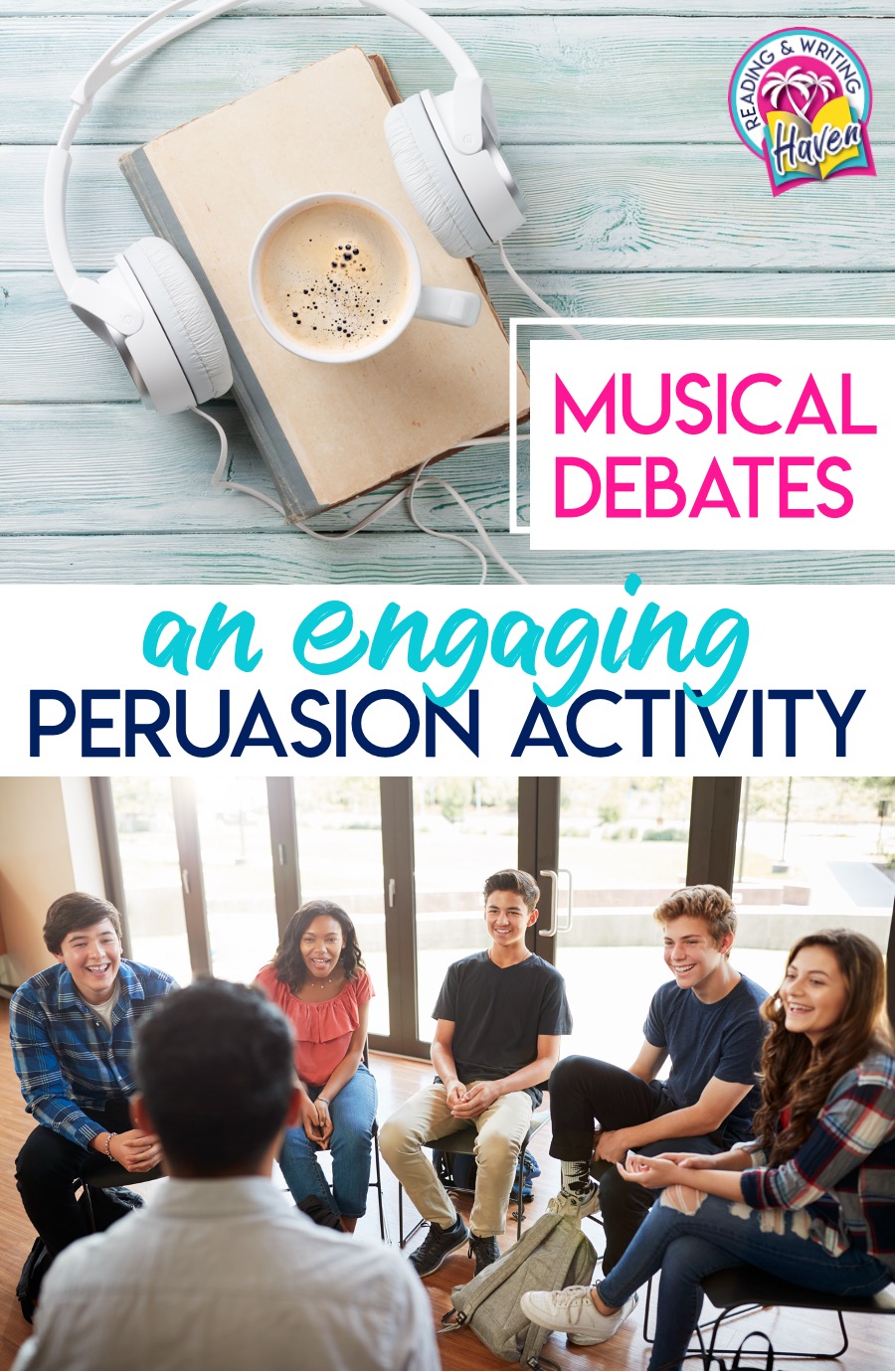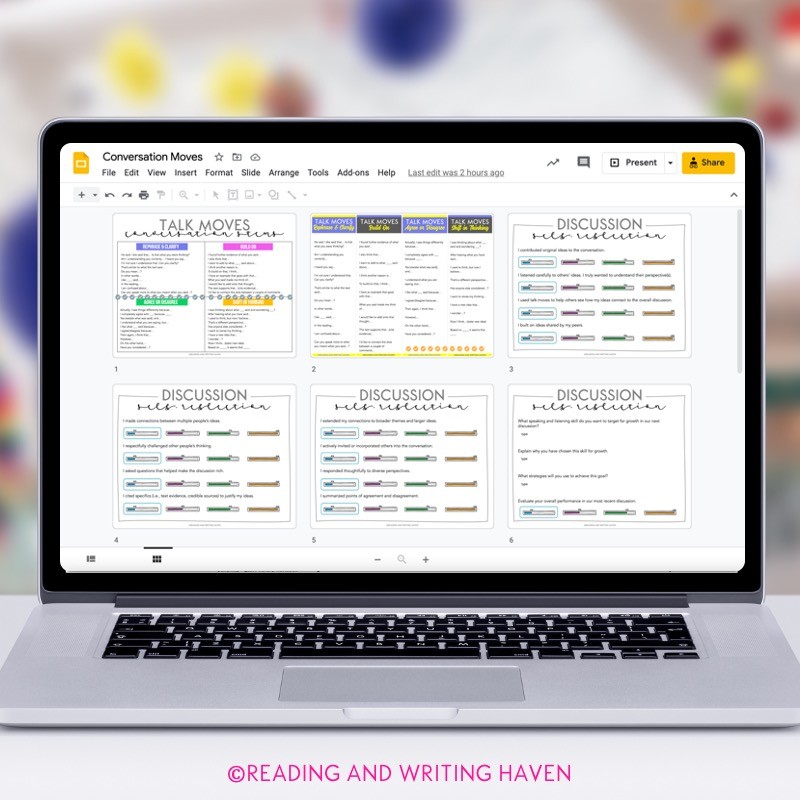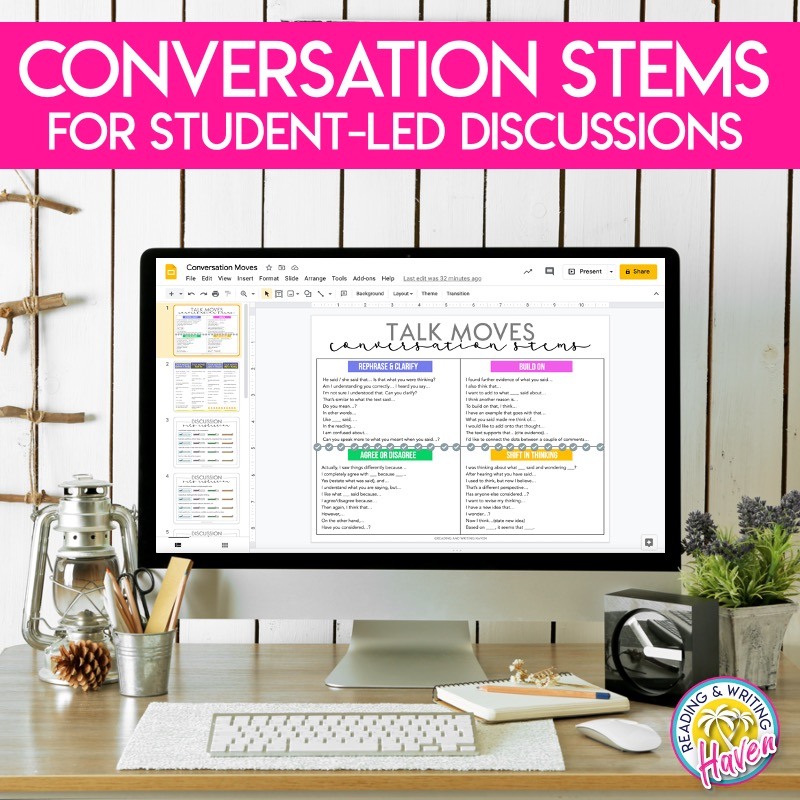How to Engage Students with Musical Debates
The world is disagreeing, and people feel disconnected. In the middle of what sometimes seems like chaos, we need to provide opportunities for students to converse…to share their ideas. Students need to learn how to respectfully disagree as well as how to listen. That’s why we need musical debates in our lives.
Argumentative speaking and writing are integral standards for middle and high school students. These skills will give students an advantage in life. With most schools facing some degree of online learning, teachers are searching for versatile strategies to teach these skills. Musical debates are one of my new favorites. You can host them online or in person, and they are flexible! Use them with a variety of discussion and writing skills.
The basic concept is to alternate music with debating. Like, this!
How to Run Musical Debates
Step 1: Start by giving students a prompt (you can find some examples later in this post).
Step 2: Then, play music. The purpose of the music is to provide an element of engagement while also giving students some time to think after hearing the prompt. While the song is playing (for approximately one minute, but you can adjust to your liking), students can be slowly walking around the room or jotting down notes of what they want to share. Movement helps the thinking process! (If students are home, they can do this as well. And, if they are confined to their seats, you may find them tapping, swaying, or bouncing.)
Step 3: After you’ve given students a minute to collect their thoughts, stop the music, and tell them to find two peers who are nearest to them. Online, you can use breakout rooms to arrange students in random trios to discuss their ideas. In person, you can have students talk with peers who are sitting close, or if they are standing, they may talk with a variety of peers (for short amounts of time).
Step 4: Choosing roles! Quickly, the trio needs to decide who is speaking for which side of the argument. The third student should be a neutral judge. Student Three will listen to both sides and summarize what he hears each person saying. You may also have the third person listen to see if any logical fallacies are used in the mini debate or be the person responsible for building on to initially shared ideas.
Step 5: Once students are in the breakout rooms (online) or facing each other (in person), Student One has one minute to share his or her points.
While Students Two and Three listen, they can be writing down an abbreviated version of what they hear the opposing viewpoint saying. This practice keeps students focused on listening instead of mentally preparing a rebuttal.
Step 6: Before Student Two responds with a rebuttal, Student Three (the neutral judge) should repeat back what Student One just said. Teach students to use language like, “I think I heard you say….Is that accurate?” or “I want to make sure I am fully understanding what you are saying. Do you think…?” Or, “I’d like to add on to what you mentioned…”
Then, Student Two has one minute to respond. During this time, Students One and Three take notes and listen.
You can run one, two, or multiple musical debates rounds in this way, playing music as students think about the next prompt, before bringing the whole class together to discuss. However, for the first time, I recommend trying it out with one round. Talk about what went well, what could be better, and try again!
Whole-Class Activity
Bring the whole class back together (either by returning to seats in person or returning to the main online meeting area). Impromptu small group or partner debates are opportunities for students to talk through their ideas before sharing with the class. Once together, you can have students share their thoughts in different ways.
4 Corners: Standing in corners to represent varying degrees of agreement and disagreement with a statement is ideal, but in our current teaching situation, that’s not always possible. Make this strategy digital by using a Jamboard, Google Slide, Padlet, or Peardeck. Students can add their names or thoughts to a sticky note or corner of a slide.
Continuum: Show where you fall on a continuum by standing shoulder-to-shoulder in a straight line that stretches across the room. Maintain social distancing by using post-its or Expo marker on a whiteboard. This activity can be done virtually as well with a shared template.
Tech: Use Mentimeter, Padlet, or a shared Jamboard slide as a tangible and visible location to share insights from the debate rounds. The whole class can use these tech platforms as a springboard for a larger conversation.
Students can then talk in a discussion format about new insights they have from the musical debate rounds. Keep a list of additional questions generated during this time, and students can research them later.
Engaging Variations
Argumentative writing and speaking standards are deep, so you can modify this general format to emphasize any skill you want students to work on.
For instance, focus on building on one another’s ideas by giving each student thirty seconds to talk. The second speaker must build on what the first speaker has said. Of course, you can still play music as students walk around the room, research to learn more about the topic, or jot down some additional thoughts as they prepare for a conversation with another peer.
Students should also be able to pose questions that connect the ideas of several speakers. Student Three, the neutral judge, could be assigned the specific task of making connections between speakers. So often in life, two people who think they disagree are not so far apart in thinking. But, because of how they are expressing their ideas, misunderstandings and divisions are created.
Also, we can help students practice analyzing the purpose of information presented in diverse media and formats. For example, we may begin with a first round of musical debates where students respond with their own thoughts. Play music. During round two, we may show a short video clip, commercial, political cartoon, or infographic. Students could then be prompted to focus their conversation on analyzing what this media adds to the argument. What bias can they detect? What is the purpose? Evaluate the social, commercial, or political motives behind its presentation.
Tweak this activity to focus on analyzing and evaluating argumentative writing by providing prompts about claims, evidence, reasoning, audience, and formality.
Prompts for Musical Discussions
This activity can be used with non-debate topics as well! Musical discussions can run the same way with any topic.
It’s easiest to start by identifying the standard(s) you want students to work on. Then, you can craft questions that get to the heart of the skills inherent in those standards.
Example: CCSS.ELA-LITERACY.RI.8.6
Determine an author’s point of view or purpose in a text and analyze how the author acknowledges and responds to conflicting evidence or viewpoints.
You could craft rounds for this standard in many ways. Here is an example setup:
- 1: What is the author’s viewpoint expressed in this text?
- 2: What do you think is the author’s purpose in creating this text? (Go beyond simply saying “to inform.)
- 3: What conflicting evidence does the author present?
- 4: How does the author respond to opposing viewpoints?
- 5: Evaluate the author’s message. What strengths and weaknesses do you see?
Of course, you can also give them fun prompts to respond to literature, practice vocabulary, or to review for a summative assessment!
How to Prepare Students
Before students participate in musical debates, you’ll want to frontload how the activity works. What norms can be established to make sure everyone has a positive experience?
Consider…
- Keep an open mind and truly listen to what others are saying.
- Use accountable talk moves to be respectful when disagreeing.
- Stay focused so that conversations can be productive with the short time frame.
- Allow your thinking to be challenged.
- When online, mute your mic if you are not speaking to reduce background noice.
- Eliminate distractions (phone, extra tabs on your device, etc.) to show respect.
- Ask questions when you don’t understand what someone has said.
Before participating in musical debates or discussions, you’ll want to talk about the format. What should students expect? It’s actually helpful to walk through one as a mock debate first. Model what each person should do during each step, and use a couple of brave volunteers to help you provide this important example.
If using musical debates online, breakout rooms can be challenging if they are new to your students. I recommend familiarizing yourself with them first and then teaching students about the features. How can they ask for help? What type of talk IS and IS NOT acceptable in these breakout rooms? Do they need to click a button when time is up so they can return to the main chat? Will a timer show so they know how long they have been speaking and when they should switch?
Discuss devil’s advocate. If a student has been tasked with talking about a side of the debate they disagree with, model how to do this gracefully so they feel more comfortable doing it themselves. Some people claim…
You may also wish to model how students should initiate the conversations and how to ask follow-up questions. Once in partners or trios, they may not know where to begin.
Benefits of this Discussion Activity
But…what is the purpose of the music? Really, you could run these mini debates without the element of music. True! But, in my experience, music can have a powerful impact in the classroom.
Engagement: Students are naturally more engaged when music is playing. Students can be moving, dancing, swaying – whatever they need to do – while maintaining social distance.
Brain Breaks: The musical breaks give students the opportunity to chunk their discussions. Brain breaks are important for helping students collect their thoughts, do some impromptu research, clear their heads, and ask questions.
Movement: Students need to get moving! Walking and talking is a great way to deflect negative energy while also prompting new thinking. It also helps with relational connections. While that music is playing, get walking!
Energy: Music amps up the energy in the classroom. Ever noticed how playing a song as students enter the room, before the bell rings, impacts the level of engagement and participation at the beginning of the period?
Mood: Music has the power to elevate moods. Have students help create the playlist if you wish! Instrumental songs can be fun because the lyrics don’t distract deep thinkers.
Creativity: Putting on some tunes in between each round of mini debates inspires divergent, innovative thinking.
Fun: Debates can be stressful for some students. Playing music releases tension and allows them to have some fun! This is so important with middle and high schoolers.
I love this musical debates meets walk and talk strategy for elevating critical thinking and energy in the secondary classroom. You truly can modify it to meet your lesson objectives, time constraints, and learning scenarios. You really won’t know how it will work best for your unique situation and students until you try it. So, what are you waiting for?
READ NEXT:
- Ways to Use Music in the Classroom
- An Engaging Music Activity for Secondary ELA
- Powerful Discussion Strategies for Any Setting
RELATED RESOURCE:
Discussion stems help middle and high school students to learn academic conversation phrases that push conversation beyond the surface level.




